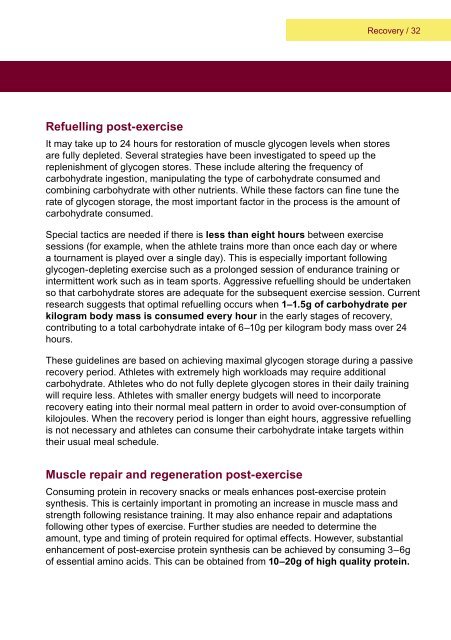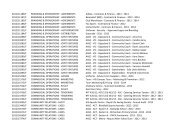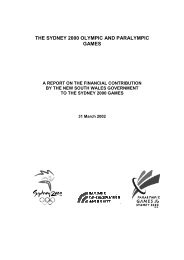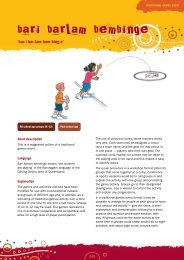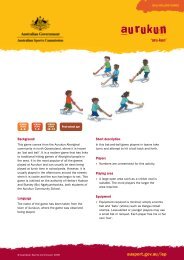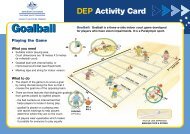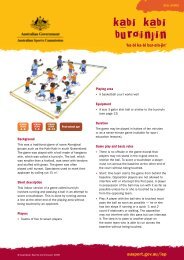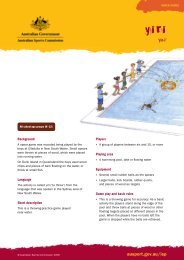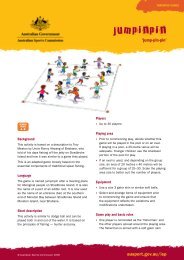Current Concepts in Sports Nutrition - Australian Sports Commission
Current Concepts in Sports Nutrition - Australian Sports Commission
Current Concepts in Sports Nutrition - Australian Sports Commission
Create successful ePaper yourself
Turn your PDF publications into a flip-book with our unique Google optimized e-Paper software.
Refuell<strong>in</strong>g post-exercise<br />
Recovery / 32<br />
It may take up to 24 hours for restoration of muscle glycogen levels when stores<br />
are fully depleted. Several strategies have been <strong>in</strong>vestigated to speed up the<br />
replenishment of glycogen stores. These <strong>in</strong>clude alter<strong>in</strong>g the frequency of<br />
carbohydrate <strong>in</strong>gestion, manipulat<strong>in</strong>g the type of carbohydrate consumed and<br />
comb<strong>in</strong><strong>in</strong>g carbohydrate with other nutrients. While these factors can f<strong>in</strong>e tune the<br />
rate of glycogen storage, the most important factor <strong>in</strong> the process is the amount of<br />
carbohydrate consumed.<br />
Special tactics are needed if there is less than eight hours between exercise<br />
sessions (for example, when the athlete tra<strong>in</strong>s more than once each day or where<br />
a tournament is played over a s<strong>in</strong>gle day). This is especially important follow<strong>in</strong>g<br />
glycogen-deplet<strong>in</strong>g exercise such as a prolonged session of endurance tra<strong>in</strong><strong>in</strong>g or<br />
<strong>in</strong>termittent work such as <strong>in</strong> team sports. Aggressive refuell<strong>in</strong>g should be undertaken<br />
so that carbohydrate stores are adequate for the subsequent exercise session. <strong>Current</strong><br />
research suggests that optimal refuell<strong>in</strong>g occurs when 1–1.5g of carbohydrate per<br />
kilogram body mass is consumed every hour <strong>in</strong> the early stages of recovery,<br />
contribut<strong>in</strong>g to a total carbohydrate <strong>in</strong>take of 6–10g per kilogram body mass over 24<br />
hours.<br />
These guidel<strong>in</strong>es are based on achiev<strong>in</strong>g maximal glycogen storage dur<strong>in</strong>g a passive<br />
recovery period. Athletes with extremely high workloads may require additional<br />
carbohydrate. Athletes who do not fully deplete glycogen stores <strong>in</strong> their daily tra<strong>in</strong><strong>in</strong>g<br />
will require less. Athletes with smaller energy budgets will need to <strong>in</strong>corporate<br />
recovery eat<strong>in</strong>g <strong>in</strong>to their normal meal pattern <strong>in</strong> order to avoid over-consumption of<br />
kilojoules. When the recovery period is longer than eight hours, aggressive refuell<strong>in</strong>g<br />
is not necessary and athletes can consume their carbohydrate <strong>in</strong>take targets with<strong>in</strong><br />
their usual meal schedule.<br />
Muscle repair and regeneration post-exercise<br />
Consum<strong>in</strong>g prote<strong>in</strong> <strong>in</strong> recovery snacks or meals enhances post-exercise prote<strong>in</strong><br />
synthesis. This is certa<strong>in</strong>ly important <strong>in</strong> promot<strong>in</strong>g an <strong>in</strong>crease <strong>in</strong> muscle mass and<br />
strength follow<strong>in</strong>g resistance tra<strong>in</strong><strong>in</strong>g. It may also enhance repair and adaptations<br />
follow<strong>in</strong>g other types of exercise. Further studies are needed to determ<strong>in</strong>e the<br />
amount, type and tim<strong>in</strong>g of prote<strong>in</strong> required for optimal effects. However, substantial<br />
enhancement of post-exercise prote<strong>in</strong> synthesis can be achieved by consum<strong>in</strong>g 3–6g<br />
of essential am<strong>in</strong>o acids. This can be obta<strong>in</strong>ed from 10–20g of high quality prote<strong>in</strong>.


